Other people related to the Moore family
- General Robert Howe was a Major General in the Continental Army and was a great-grandson of Governor James Moore.
The Moore family was a prominent political family, who claimed direct descent from the Gaelic nobility of Ireland, in North and South Carolina during the 18th and 19th centuries. They claimed descent from Rory O'More, Chief of the Name of the Clan O'More, Lord of Laois, and leader of the Irish Rebellion of 1641. The family is most closely associated with the Cape Fear coastal region around Wilmington. Several members of the family held prominent political positions in colonial North and South Carolina, were senior officers in the Continental Army during the American Revolutionary War, or held high positions in the United States Federal Government during the early years of the republic.
James Moore Sr. was the patriarch of the family. He served as the governor of the Carolina from 1700-1703. He had two prominent sons, James Jr. and Maurice.
James Moore Jr. was a colonel in the colonial militia who served in the Yamassee War and would be a governor of the Province of South Carolina after North and South Carolina split. He served in that position 1719-1721.
Maurice had been a speaker of the North Carolina legislature. As speaker the Maurice Moore had championed settlement of the Cape Fear region under Governor George Burrington and led frequent conflicts with Burrington's successor, Richard Everard. Maurice had two sons, named James and Maurice.
Maurice Moore II had been appointed as a Judge, but when the younger Maurice became a vocal opponent of the Stamp Act, he was removed from the bench by Governor William Tryon. Both he and his brother James served in the colonial legislature. He had at least one son, Alfred.
General James Moore served in the Continental Army, first as a colonel, and later, after he distinguished himself leading the troops at the Battle of Moore's Creek Bridge, as a Brigadier General and commander of the Southern Department, a position he would only hold for a few months before his sudden death in April, 1777.
Alfred Moore would serve as an officer in the Continental Army, and later as an Associate Justice of the United States Supreme Court.
Francis Nash was a brigadier general in the Continental Army during the American Revolutionary War. Prior to the war, he was a lawyer, public official, and politician in Hillsborough, North Carolina, and was heavily involved in opposing the Regulator movement, an uprising of settlers in the North Carolina piedmont between 1765 and 1771. Nash was also involved in North Carolina politics, representing Hillsborough on several occasions in the colonial North Carolina General Assembly.

Lieutenant-General William Tryon was a British Army officer and colonial administrator who served as governor of North Carolina from 1764 to 1771 and the governor of New York from 1771 to 1777. He also served during the Seven Years' War, the Regulator Movement, and the American War of Independence.
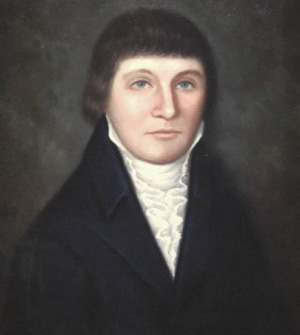
Richard Caswell was an American politician and lawyer who served as the first and fifth governor of the U.S. state of North Carolina from 1776 to 1780 and from 1785 to 1787. He also served as a senior officer of militia in the Southern theater of the American Revolutionary War. As a delegate to the First Continental Congress, he was a signatory of the 1774 Continental Association.
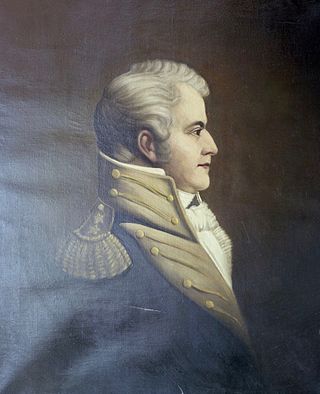
Benjamin Smith was the 16th Governor of the U.S. state of North Carolina from 1810 to 1811.

Robert Howe was a Continental Army general from the Province of North Carolina during the American Revolutionary War. The descendant of a prominent family in North Carolina, Howe was one of five generals, and the only major general, in the Continental Army from that state. He also played a role in the colonial and state governments of North Carolina, serving in the legislative bodies of both.
Barnard Elliot Bee Sr. (1787–1853) was an American attorney and politician. A native of South Carolina, he, with his family, was an early settler of the Republic of Texas. He became a political leader there, serving in several political-appointee positions in the republic.
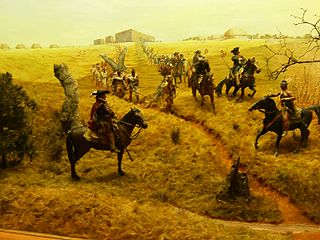
James Moore Sr. was an Irish-born military officer and colonial administrator who served as the governor of Carolina from 1700 to 1703. He is best known for leading several invasions of Spanish Florida during Queen Anne's War, including attacks in 1704 and 1706 which wiped out most of the Spanish missions in Florida. He captured and brought back to Carolina as slaves thousands of Roman Catholic Apalachee Indians.
Edward Moseley, was a British colonial official who served as the first public treasurer of North Carolina from 1715 until his death in July 1749). He previously served as the surveyor-general of North Carolina before 1710 and again from 1723 to 1733. Moseley was also responsible, with William Byrd of Virginia, for surveying the boundary between North Carolina and Virginia in 1728.
The 1st North Carolina Regiment of the Continental Army was raised on September 1, 1775, at Wilmington, North Carolina. In January 1776 the organization contained eight companies. Francis Nash was appointed colonel in April 1776. The regiment was present at the defense of Charleston in 1776. It transferred from the Southern Department to George Washington's main army in February 1777. At that time, Thomas Clark became colonel of the 1st Regiment. The regiment became part of General Francis Nash's North Carolina Brigade in July.
John Ashe, Sr. was Speaker of the House of Burgesses in the Province of North Carolina. He was Harvard educated and fought in the North Carolina militia during the French and Indian War. During the American Revolution, he attained the rank of major general and was in charge of North Carolina militia and state troops from 1776 to 1779. He resigned from military service after the Patriot defeat at the Battle of Brier Creek in 1779.
George Burrington was a British colonial official who served as the third and fifth governor of North Carolina from 1724 to 1725 and 1731 to 1734. He is noted for opening the lower Cape Fear region to settlement. From the outset of his administration, he encountered opposition to his authority. In 1733 he noted that African slave ships did not bring their trade to his colony.
Nathaniel Rice was a British colonial administrator who served as the acting governor of North Carolina in 1734 and from 1752 to 1753.
James Moore was a Continental Army general during the American Revolutionary War. Moore was born into a prominent political family in the colonial Province of North Carolina, he was one of only five generals from North Carolina to serve in the Continental Army. He spent much of his childhood and youth on his family's estates in the lower Cape Fear River area, but soon became active in the colonial military structure in North Carolina.

The Orton Plantation is a historic plantation house in the Smithville Township of Brunswick County, North Carolina, United States. Located beside the Cape Fear River between Wilmington and Southport, Orton Plantation is considered to be a near-perfect example of Southern antebellum architecture. Built in 1735 by the co-founder of Brunswick Town, Colonel Maurice Moore, the Orton Plantation house is one of the oldest structures in Brunswick County. During its history Orton Plantation has been attacked by Native Americans, used as a military hospital, and been home to lawyers, physicians, military leaders, and a Colonial governor.
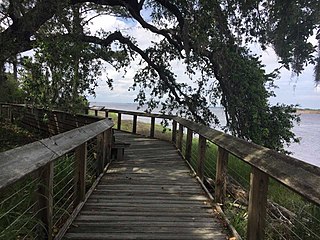
Brunswick Town was a prominent town in colonial North Carolina. It was the first successful European settlement in the Cape Fear region, a major British port in the 18th century, and home to two provincial governors. Brunswick Town lasted 50 years (1726–1776) until it was raided by the British Army during the American Revolutionary War and never rebuilt. During the American Civil War, 86 years after the town was abandoned, a large portion of the town was covered by earthworks for the construction of Fort Anderson.
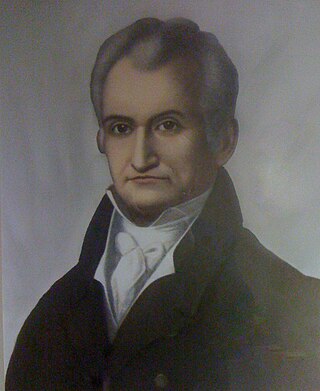
Colonel William Polk was a North Carolina banker, educational administrator, political leader, renowned Continental officer in the War for American Independence, and survivor of the 1777/1778 encampment at Valley Forge.

Alfred Moore was an American judge, lawyer, planter and military officer who became an associate justice of the Supreme Court of the United States. Moore Square, a park located in the Moore Square Historic District in Raleigh, North Carolina, was named in his honor, as was Moore County, North Carolina. He was also a founder and trustee of the University of North Carolina at Chapel Hill.

Thomas Polk was a planter, military officer in the Continental Army during the American Revolutionary War from 1775 to 1781, and a politician who served in the North Carolina House of Commons, North Carolina Provincial Congress, and Council of State. Polk commanded the 4th North Carolina Regiment in the Battle of Brandywine. In 1786, Polk was elected by the North Carolina General Assembly to the Congress of the Confederation, but did not attend any of its sessions. Polk was a great-uncle of the 11th President of the United States, James K. Polk.
The Hyde County Regiment was a unit of the North Carolina militia that served during the American Revolution. Hyde County, formed in 1705, had a militia in colonial times that was used to defend the coast of the Province of North Carolina. The North Carolina General Assembly authorized the Hyde County Regiment on September 9, 1775, along with 34 other county regiments. The officers were appointed and commissioned by the Governor of North Carolina. The regiment was subordinated to the New Bern District Brigade of North Carolina militia on May 4, 1776. The regiment was disbanded at the end of the war.